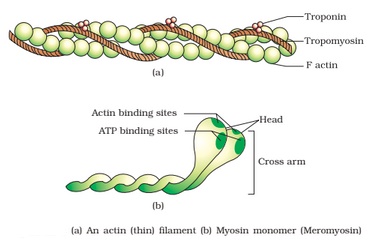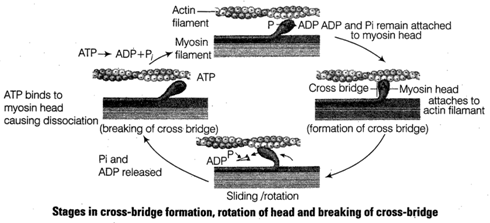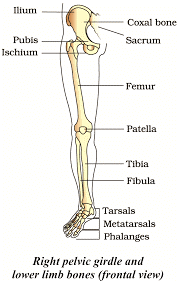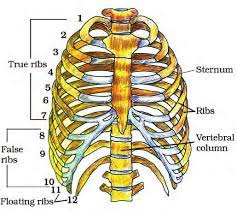Locomotion and Movement
Types of Movement:
- Cells of the human body exhibit three main types of movements, namely, amoeboid, ciliary and muscular.
- Some specialized cells in our body like macrophages and leucocytes in blood exhibit amoeboid movement.
- It is affected by pseudopodia formed by the streaming of protoplasm (as in Amoeba).
- Cytoskeletal elements like microfilaments are also involved in the amoeboid movement.
- Ciliary movement occurs in most of our internal tubular organs which are lined by ciliated epithelium.
- The coordinated movements of cilia in the trachea help us in removing dust particles and some of the foreign substances inhaled along with the atmospheric air.
- The passage of ova through the female reproductive tract is also facilitated by ciliary movement.
- Movement of our limbs, jaws, tongue, etc, requires muscular movement.
- The contractile property of muscles is effectively used for locomotion and other movements by human beings and the majority of multicellular organisms.
- Locomotion requires a perfectly coordinated activity of muscular, skeletal, and neural systems.
Muscle:
- Cilia and flagella are the outgrowths of the cell membrane.
- Flagellar movement helps in the swimming of spermatozoa, maintenance of water current in the canal system of sponges, and in the locomotion of Protozoans like Euglena.
- Muscle is a specialized tissue of mesodermal origin.
- About 40-50 percent of the body weight of a human adult is contributed by muscles.
- They have special properties like excitability, contractility, extensibility, and elasticity.
- Muscles have been classified using different criteria, namely location, appearance, and nature of regulation of their activities.
Based on their location, three types of muscles are identified :
- Skeletal
- Skeletal muscles are closely associated with the skeletal components of the body.
- They have a striped appearance under the microscope and hence are called striated muscles.
- As their activities are under the voluntary control of the nervous system, they are known as voluntary muscles too.
- They are primarily involved in locomotory actions and changes in body postures.
- Visceral
- Visceral muscles are located in the inner walls of hollow visceral organs of the body like the alimentary canal, reproductive tract, etc.
- They do not exhibit any striation and are smooth in appearance.
- Hence, they are called smooth muscles (nonstriated muscles).
- Their activities are not under the voluntary control of the nervous system and are therefore known as involuntary muscles.
- They assist, for example, in the transportation of food through the digestive tract and gametes through the genital tract.
- Cardiac.
- They are the muscles of the heart.
- Many cardiac muscle cells assemble in a branching pattern to form a cardiac muscle.
- Based on appearance, cardiac muscles are striated.
- They are involuntary in nature as the nervous system does not control their activities directly.
Skeletal Muscle:
Each organized skeletal muscle in our body is made of a number of muscle bundles or fascicles held together by a common collagenous connective tissue layer called fascia.
- Each muscle bundle contains a number of muscle fibres.
- Each muscle fibre is lined by the plasma membrane called sarcolemma enclosing the sarcoplasm.
- A muscle fibre is a syncitium as the sarcoplasm contains many nuclei.
- The endoplasmic reticulum, i.e., the sarcoplasmic reticulum of the muscle fibres is the storehouse of calcium ions.
- A characteristic feature of the muscle fibre is the presence of a large number of parallelly arranged filaments in the sarcoplasm called myofilaments or myofibrils.
- Each myofibril has alternate dark and light bands on it.
- Myofibril has a striated appearance which is due to the distribution pattern of two important proteins – Actin and Myosin.
- The light bands contain actin and are called I-band or Isotropic band, whereas the dark band called ‘A’ or Anisotropic band contains myosin.
- Both proteins are arranged as rod-like structures, parallel to each other and also to the longitudinal axis of the myofibrils.
- Actin filaments are thinner as compared to myosin filaments, hence are commonly called thin and thick filaments respectively.
- In the centre of each ‘I’ band is an elastic fibre called the ‘Z’ line which bisects it.
- The thin filaments are firmly attached to the ‘Z’ line.
- The thick filaments in the ‘A’ band are also held together in the middle of this band by a thin fibrous membrane called the ‘M’ line.
- The ‘A’ and ‘I’ bands are arranged alternately throughout the length of the myofibrils.
- The portion of the myofibril between two successive ‘Z’ lines is considered the functional unit of contraction and is called a sarcomere.
- In a resting state, the edges of thin filaments on either side of the thick filaments partially overlap the free ends of the thick filaments leaving the central part of the thick filaments.
- This central part of the thick filament, not overlapped by thin filaments is called the ‘H’ zone.

Structure of Contractile Proteins:
Each actin (thin) filament is made of two ‘F’ (filamentous) actins helically wound to each other.
- Each ‘F’ actin is a polymer of monomeric ‘G’ (Globular) actins.
Two filaments of another protein, tropomyosin also run close to the ‘F’ actins throughout its length.
- A complex protein Troponin is distributed at regular intervals on the tropomyosin.
- In the resting state a subunit of troponin masks the active binding sites for myosin on the actin filaments.
Each myosin (thick) filament is also a polymerised protein.
- Many monomeric proteins called Meromyosins constitute one thick filament.
- Each meromyosin has two important parts, a globular head with a short arm and a tail, the former being called the heavy meromyosin (HMM) and the latter, the light meromyosin (LMM).
- The HMM component, i.e.; the head and short arm projects outwards at a regular distance and angle from each other from the surface of a polymerised myosin filament and is known as a cross arm.
The globular head is an active ATPase enzyme and has binding sites for ATP and active sites for actin.

Mechanism of Muscle Contraction:
The mechanism of muscle contraction is best explained by the sliding filament theory which states that contraction of a muscle fibre takes place by the sliding of the thin filaments over the thick filaments.
Muscle contraction is initiated by a signal sent by the central nervous system (CNS) via a motor neuron.
- A motor neuron along with the muscle fibres connected to it constitute a motor unit.
- The junction between a motor neuron and the sarcolemma of the muscle fibre is called the neuromuscular junction or motor-end plate.
- A neural signal reaching this junction releases a neurotransmitter (Acetylcholine) which generates an action potential in the sarcolemma.
- This spreads through the muscle fibre and causes the release of calcium ions into the sarcoplasm.
- An increase in Ca++ level leads to the %%binding of calcium with a subunit of troponin on actin filaments%% and thereby removes the masking of active sites for myosin.
- Utilising the energy from ATP hydrolysis, the %%myosin head now binds to the exposed active sites%% on actin to form a cross bridge.
- This pulls the attached actin filaments towards the %%centre of the ‘A’ band.%%
- The ‘Z’ line attached to these actins is also pulled inwards thereby causing a %%shortening of the sarcomere, i.e., contraction.%%
- It is clear from the above steps, that during shortening of the muscle, i.e., %%contraction, the ‘I’ bands get reduced, whereas the ‘A’ bands retain their length.%%
- The myosin, releasing %%the ADP and P1%% goes back to its relaxed state.
- A new ATP binds and the cross-bridge is broken.
- The ATP is again hydrolysed by the %%myosin head and the cycle of cross-bridge formation%% and breakage is repeated causing further sliding.
- The process continues till the Ca++ ions are pumped back to the sarcoplasmic cisternae resulting in the %%masking of actin filaments.%%
- This causes the return of %%‘Z’ lines%% back to their original position, i.e., relaxation.
The reaction time of the fibres can vary in different muscles.
- Repeated activation of the muscles can lead to the accumulation of lactic acid due to the %%anaerobic breakdown of glycogen in them, causing fatigue.%%
%%Muscle contains a red-coloured oxygen-storing pigment called myoglobin.%%
- Myoglobin content is high in some of the muscles which give a reddish appearance.
- %%Such muscles are called the Red fibres.%%
- These muscles also contain %%plenty of mitochondria%% which can utilise a large amount of oxygen stored in them for ATP production.
- These muscles, therefore, can also be called aerobic muscles.
- On the other hand, some of the %%muscles possess a very less quantity of myoglobin%% and therefore, appear pale or whitish.
- These are the %%White fibres%%.
- A number of mitochondria are also few in them, but the amount of %%sarcoplasmic reticulum is high%%.
- They depend on the %%anaerobic processes for energy.%%


Skeletal System:
The skeletal system consists of a %%framework of bones and a few cartilages.%%
- This system has a significant role in the movement shown by the body.
Bone and cartilage are specialised connective tissues.
- The former has a very hard matrix due to calcium salts in it and the latter has a slightly pliable matrix due to %%chondroitin salts.%%
In human beings, this system is made up of %%206 bones and a few cartilages.%%
It is grouped into two principal divisions – the axial and the appendicular skeleton.
The axial skeleton comprises %%80 bones%% distributed along the main axis of the body.
- The %%skull, vertebral column, sternum and ribs constitute the axial skeleton.%%
The skull is composed of two sets of bones –
- %%Cranial bones are 8 in number.%%
- They form the %%hard protective outer covering, cranium%% for the brain.
- The %%facial region is made up of 14 skeletal elements%% which form the front part of the skull.
- A %%single U-shaped bone called hyoid%% is present at the base of the buccal cavity and it is also included in the skull.
- Each middle ear contains three tiny bones – %%Malleus, Incus and Stapes, collectively called Ear Ossicles.%%
The skull region articulates with the superior region of the vertebral column with the help of two occipital condyles (dicondylic skull).
Our vertebral column is formed by 2%%6 serially arranged units called vertebrae%% and is dorsally placed.
- It extends from the base of the skull and constitutes the %%main framework of the trunk.%%
- Each vertebra has a central hollow portion (neural canal) through which the spinal cord passes.
- The %%first vertebra is the atlas and it articulates with the occipital condyles.%%
- The vertebral column is differentiated into cervical (7), thoracic (12), lumbar (5), sacral (1-fused) and coccygeal (1-fused) regions starting from the skull.
- The %%number of cervical vertebrae is seven%% in almost all mammals including human beings.
- The %%vertebral column protects the spinal cord, supports the head and serves as the point of attachment for the ribs and musculature of the back.%%
%%Sternum is a flat bone on the ventral midline of thorax.%%
There are %%12 pairs of ribs%%.
- Each rib is a thin flat bone connected %%dorsally to the vertebral column and ventrally to the sternum.%%
- It has two articulation surfaces on its dorsal end and is hence called bicephalic.
- First, %%seven pairs of ribs are called%% %%true ribs.%%
- Dorsally, they are attached to the %%thoracic vertebrae and ventrally connected to the sternum%% with the help of hyaline cartilage.
- The %%8th, 9th and 10th pairs of ribs do not articulate directly%% with the sternum but join the %%seventh rib with the help of hyaline cartilage.%%
- These are called vertebrochondral (false) ribs.
- The %%last 2 pairs (11th and 12th) of ribs are not connected ventrally and are, therefore, called floating ribs.%%
- %%Thoracic vertebrae, ribs and sternum together form the rib cage.%%
The bones of the limbs along with their girdles constitute the appendicular skeleton.
- %%Each limb is made of 30 bones.%%
- The bones of the hand (fore limb) are the humerus, radius and ulna, carpals (wrist bones – 8 in number), metacarpals (palm bones – 5 in number) and phalanges (digits – 14 in number).
- The femur (thigh bone – the longest bone), tibia and fibula, tarsals (ankle bones – 7 in number), metatarsals (5 in number) and phalanges (digits – 14 in number) are the bones of the legs (hind limb).
A cup-shaped bone called the patella covers the %%knee ventrally (knee cap).%%
Pectoral and Pelvic girdle bones help in the %%articulation of the upper and the lower limbs%% respectively with the axial skeleton.
- Each girdle is formed of two halves.
- Each half of the pectoral girdle consists of a clavicle and a scapula.
- The %%scapula is a large triangular flat bone%% situated in the dorsal part of the thorax between the second and the seventh ribs.
- The dorsal, flat, triangular body of the scapula has a %%slightly elevated ridge called the spine%% which projects as a flat, expanded process called the acromion.
- The clavicle articulates with this.
- Below the %%acromion is a depression called the glenoid cavity%% which articulates with the head of the humerus to form the shoulder joint.
Each %%clavicle is a long slender bone%% with two curvatures.
- This bone is commonly called the collar bone.
The pelvic girdle consists of %%two coxal bones.%%
- Each coxal bone is formed by the fusion of three bones – %%ilium, ischium and pubis.%%
- At the point of fusion of the above bones is a cavity called acetabulum to which the %%thigh bone articulates.%%
The %%two halves of the pelvic girdle meet ventrally to form the pubic symphysis containing fibrous cartilage.%%




Joints:
- Joints are essential for all types of movements involving the bony parts of the body.
- Locomotory movements are no exception to this.
- Joints are points of contact between %%bones, or between bones and cartilages.%%
- Force generated by the muscles is used to carry out movement through joints, where the %%joint acts as a fulcrum.%%
- The movability at these joints varies depending on different factors.
- Joints have been classified into three major structural forms.
Fibrous Joint:
- They %%do not allow any movement.%%
- This type of joint is shown by the flat skull bones which fuse end-to-end with the help of dense fibrous connective tissues in the form of sutures, to form the cranium.
Cartilaginous Joints:
- In these, bones involved are joined together with the help of cartilages.
- The joint between the adjacent vertebrae in the vertebral column is of this pattern and it permits limited movements.
Synovial Joints:
- They are characterised by the presence of a %%fluid-filled synovial cavity%% between the articulating surfaces of the two bones.
- Such an arrangement allows considerable movement.
- These joints help in %%locomotion and many other movements.%%
- %%Ball and socket joint (between the humerus and pectoral girdle), hinge joint (knee joint), pivot joint (between atlas and axis), gliding joint (between the carpals) and saddle joint (between carpal and metacarpal of thumb)%% are some examples.
Disorders of Skeletal and Muscular System:
Myasthenia gravis:
- The autoimmune disorder affects the neuromuscular junction leading to %%fatigue, weakening and paralysis of skeletal muscle.%%
Muscular dystrophy:
- The %%progressive degeneration of skeletal muscle is mostly due to genetic disorders.%%
Arthritis:
- Inflammation of joints.
Osteoporosis:
- An age-related disorder is characterised by %%decreased bone mass and increased chances of fractures.%%
- Decreased levels of %%estrogen are a common cause.%%
Gout:
- Inflammation of joints due to %%accumulation of uric acid crystals.%%